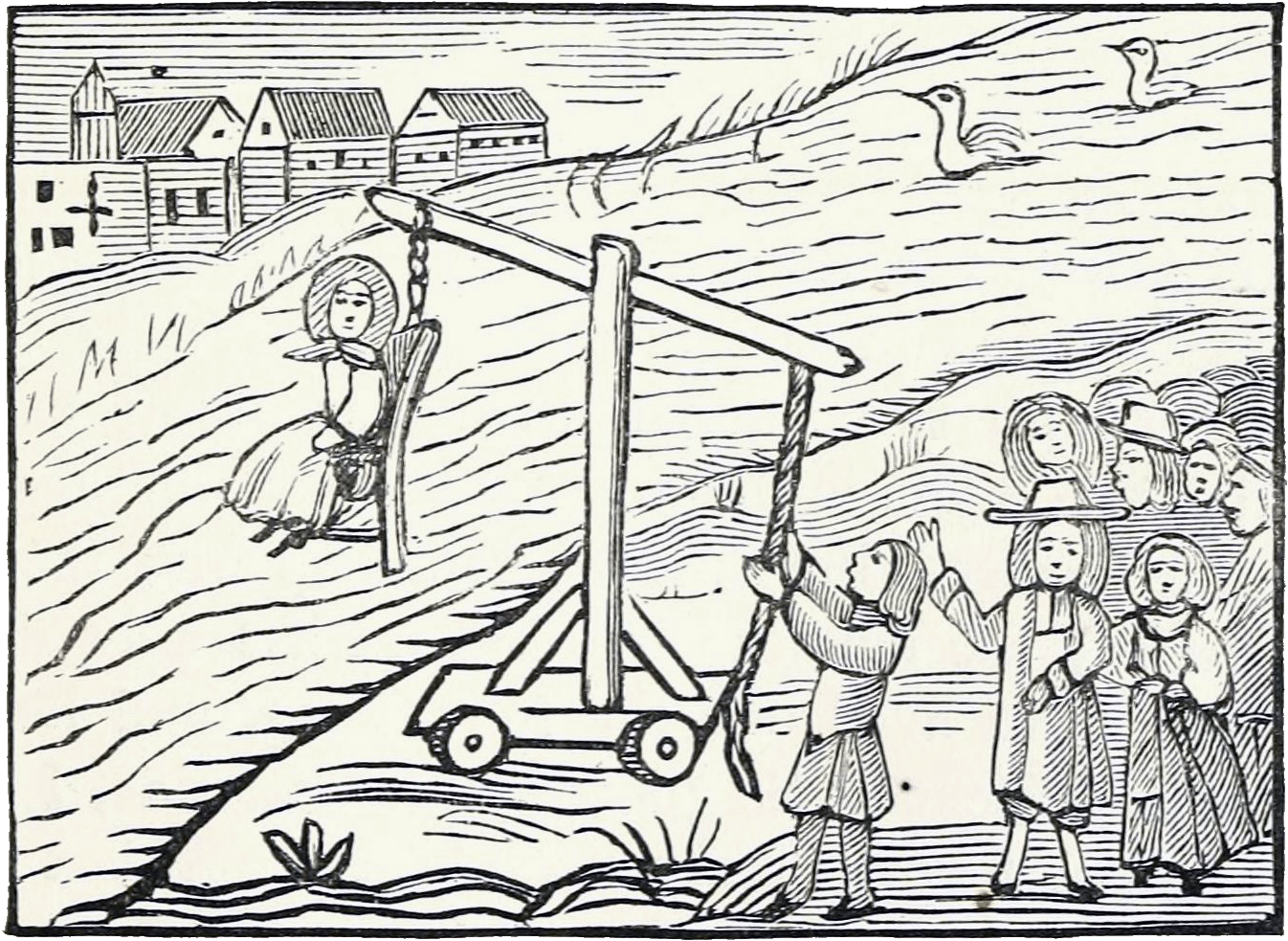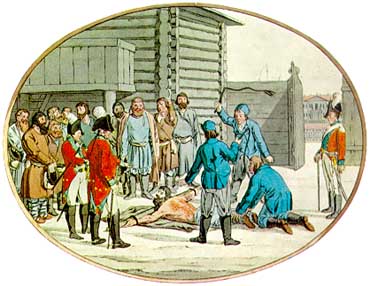|
Batog
A batog is a rod or stick about the thickness of a man's finger traditionally used for corporal punishment in Russia. The condemned was stretched on the floor face down with his back exposed while two men sat on him, one holding down the arms the other on the legs. The two men would then begin beating the victim across the back, replacing their batogs if they broke, until ordered to stop. The punishment was not usually fatal. Peter the Great used this form of punishment, along with much harsher measures such as the breaking wheel, during the Streltsy Uprising in 1698. See also *Caning *Knout A knout is a heavy scourge-like multiple whip, usually made of a series of rawhide thongs attached to a long handle, sometimes with metal wire or hooks incorporated. The English word stems from a spelling-pronunciation of a French transliterat ... References {{reflist Medieval instruments of torture European instruments of torture Corporal punishments Peter the Great ru:Бато ... [...More Info...] [...Related Items...] OR: [Wikipedia] [Google] [Baidu] |
Medieval Instruments Of Torture
A list of torture methods and devices includes: Psychological torture methods *Being subjected to long periods of interrogation *Blackmailing *Chinese water torture *Exploitation of phobias; e.g., mock execution, leaving arachnophobia, arachnophobes in a room full of spiders *Castor oil#Punishment, Castor oil *Forced nudity *Music torture *Pharmacological torture *Sensory deprivation *Sensory overload *Sleep deprivation *Solitary confinement/Social isolation, Isolation *Threat of permanent, severe disfigurement *Tickle torture *Waterboarding *White torture, White room torture Physical torture methods Instruments of torture Note that the line between "torture method" and "torture device" is often blurred, particularly when a specifically named implement is but one component of a method. Also, many devices that can be used for torture have mainstream uses, completely unrelated to torture. Medieval and early modern instruments of torture Chair of Torture Appearance Th ... [...More Info...] [...Related Items...] OR: [Wikipedia] [Google] [Baidu] |
Jean-Baptiste Le Prince, Supplice Des Batogues (c
Jean-Baptiste is a male French name, originating with Saint John the Baptist, and sometimes shortened to Baptiste. The name may refer to any of the following: Persons * Charles XIV John of Sweden, born Jean-Baptiste Jules Bernadotte, was King of Sweden and King of Norway * Charles-Jean-Baptiste Bouc, businessman and political figure in Lower Canada * Felix-Jean-Baptiste-Joseph Nève, orientalist and philologist * Gui-Jean-Baptiste Target, French lawyer and politician * Hippolyte Jean-Baptiste Garneray, French painter * Jean-Baptiste (songwriter), American music record producer, singer-songwriter * Jean-Baptiste Alphonse Karr, French critic, journalist, and novelist * Jean-Baptiste Bagaza, chairman of Supreme Revolutionary Council in Burundi until 1976 and president of Burundi (1976-1987) * Jean-Baptiste Baudry, son of Guillaume Baudry, Canadian gunsmith bevear goldsmith * Jean-Baptiste Benoît Eyriès, French geographer, author and translator * Jean-Baptiste Bessières, duke ... [...More Info...] [...Related Items...] OR: [Wikipedia] [Google] [Baidu] |
Russia
Russia (, , ), or the Russian Federation, is a List of transcontinental countries, transcontinental country spanning Eastern Europe and North Asia, Northern Asia. It is the List of countries and dependencies by area, largest country in the world, with its internationally recognised territory covering , and encompassing one-eighth of Earth's inhabitable landmass. Russia extends across Time in Russia, eleven time zones and shares Borders of Russia, land boundaries with fourteen countries, more than List of countries and territories by land borders, any other country but China. It is the List of countries and dependencies by population, world's ninth-most populous country and List of European countries by population, Europe's most populous country, with a population of 146 million people. The country's capital and List of cities and towns in Russia by population, largest city is Moscow, the List of European cities by population within city limits, largest city entirely within E ... [...More Info...] [...Related Items...] OR: [Wikipedia] [Google] [Baidu] |
Peter The Great
Peter I ( – ), most commonly known as Peter the Great,) or Pyotr Alekséyevich ( rus, Пётр Алексе́евич, p=ˈpʲɵtr ɐlʲɪˈksʲejɪvʲɪtɕ, , group=pron was a Russian monarch who ruled the Tsardom of Russia from to 1721 and subsequently the Russian Empire until his death in 1725, jointly ruling with his elder half-brother, Ivan V until 1696. He is primarily credited with the modernisation of the country, transforming it into a European power. Through a number of successful wars, he captured ports at Azov and the Baltic Sea, laying the groundwork for the Imperial Russian Navy, ending uncontested Swedish supremacy in the Baltic and beginning the Tsardom's expansion into a much larger empire that became a major European power. He led a cultural revolution that replaced some of the traditionalist and medieval social and political systems with ones that were modern, scientific, Westernised and based on the Enlightenment. Peter's reforms had a lasting ... [...More Info...] [...Related Items...] OR: [Wikipedia] [Google] [Baidu] |
Breaking Wheel
The breaking wheel or execution wheel, also known as the Wheel of Catherine or simply the Wheel, was a torture method used for public execution primarily in Europe from antiquity through the Middle Ages into the early modern period by breaking the bones of a criminal or bludgeoning them to death. The practice was abolished in Bavaria in 1813 and in the Electorate of Hesse in 1836: the last known execution by the "Wheel" took place in Prussia in 1841. In the Holy Roman Empire it was a "mirror punishment" for highwaymen and street thieves, and was set out in the ''Sachsenspiegel'' for murder, and arson that resulted in fatalities. Punishment Those convicted as murderers, rapists, traitors and/or robbers to be executed by the wheel, sometimes termed to be "wheeled" or "broken on the wheel", would be taken to a public stage scaffold site and tied to the floor. The execution wheel was typically a large wooden spoked wheel, the same as was used on wooden transport carts and c ... [...More Info...] [...Related Items...] OR: [Wikipedia] [Google] [Baidu] |
Caning
Caning is a form of corporal punishment consisting of a number of hits (known as "strokes" or "cuts") with a single Stick-fighting, cane usually made of rattan, generally applied to the offender's bare or clothed buttocks (see spanking) or hands (on the palm). Caning on the knuckles or shoulders is much less common. Caning can also be applied to the soles of the feet (foot whipping or Foot whipping, bastinado). The size and flexibility of the cane and the mode of application, as well as the number of the strokes, vary greatly—from a couple of light strokes with a small cane across the seat of a junior schoolboy's trousers, to up to 24 very hard, wounding cuts on the bare buttocks with a large, heavy, soaked rattan as a judicial punishment in some Southeast Asian countries. Flagellation was so common in England as punishment that caning, along with spanking and Flagellation, whipping, are called "the English vice". Caning can also be done consensually as a part of BDSM. The ... [...More Info...] [...Related Items...] OR: [Wikipedia] [Google] [Baidu] |
Knout
A knout is a heavy scourge-like multiple whip, usually made of a series of rawhide thongs attached to a long handle, sometimes with metal wire or hooks incorporated. The English word stems from a spelling-pronunciation of a French transliteration of the Russian word кнут (''knut''), which simply means "whip". The original Some claim it was a Tatar invention and was introduced into Russia in the 15th century, perhaps by Grand Duke Ivan III the Great (1462–1505). Others trace the word to Varangians and derive it from the Swedish ''knutpiska'', a kind of whip with ''knots''. Still others maintain it is of generic Germanic origin, not necessarily Scandinavian, comparing it with the German ''Knute'', Dutch ''knoet'' (both meaning knout) and with Old Norse ''knutr'', Anglo-Saxon ''cnotta'' and English ''knot''. The Russian knout had different forms. One was a lash of rawhide, long, attached to a wooden handle, long. The lash ended in a metal ring, to which was attached a ... [...More Info...] [...Related Items...] OR: [Wikipedia] [Google] [Baidu] |
European Instruments Of Torture
European, or Europeans, or Europeneans, may refer to: In general * ''European'', an adjective referring to something of, from, or related to Europe ** Ethnic groups in Europe ** Demographics of Europe ** European cuisine, the cuisines of Europe and other Western countries * ''European'', an adjective referring to something of, from, or related to the European Union ** Citizenship of the European Union ** Demographics of the European Union In publishing *The European (1953 magazine), ''The European'' (1953 magazine), a far-right cultural and political magazine published 1953–1959 *The European (newspaper), ''The European'' (newspaper), a British weekly newspaper published 1990–1998 *The European (2009 magazine), ''The European'' (2009 magazine), a German magazine first published in September 2009 *''The European Magazine'', a magazine published in London 1782–1826 *''The New European'', a British weekly pop-up newspaper first published in July 2016 Other uses * * Europeans ... [...More Info...] [...Related Items...] OR: [Wikipedia] [Google] [Baidu] |
Corporal Punishments
Corporal is a military rank in use in some form by many militaries and by some police forces or other uniformed organizations. The word is derived from the medieval Italian phrase ("head of a body"). The rank is usually the lowest ranking non-commissioned officer. In some militaries, the rank of corporal nominally corresponds to commanding a section or squad of soldiers. By country Argentina NCOs in the Argentine Armed Forces are divided into junior and senior NCOs, with three and four ranks, respectively. The three junior ranks are called "corporal" (cabo) in both the Navy and the Air Force, while in the Army the third rank is called "sergeant" (sargento). National Gendarmerie and Coast Guard junior NCOs ranks are similar to those in the Army and Navy, respectively. Australia Corporal is the second lowest of the non-commissioned officer ranks in the Australian Army, falling between lance-corporal and sergeant. A corporal is usually appointed as a section comman ... [...More Info...] [...Related Items...] OR: [Wikipedia] [Google] [Baidu] |



